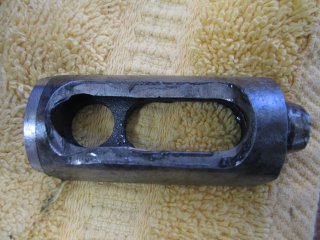I believe the new tappets of made without any pad. The whole tappet is made of the hardened material. I had a pad break off of a follower while I was idling in my driveway prior to taking off for a ride. The bike was idling away as I zipped my jacket or put my gloves on, then all of a sudden a very loud "Tap, Tap, Tap, Tap" started. I didn't let it run more than 30 seconds and switched it off. I knew something let go so I had to look so after it cooled down I pulled the head and then the barrels. When I looked down at the cam one lobe had a chunk of something blocking my view. I had no idea WTF happened, then I looked at the underside of the barrels and one follower was clearly missing the pad... which was the chunk of metal sitting in place on top of the cam lobe so it never had a chance to shoot through the crankcase.
It was a clean delamination of the pad from the body of the tappet and the cam lobe was still perfect. Jim Comstock took pity on me and I sent him the pair of tappets with the delaminated one and he cleverly matched my tappets up to his best fitting barrel and he sent me a pair of tappets back that should (and did) fit my barrel. (smart dude) Those tappets have been in for many years and that was the last time my engine was opened up.
From asking Jim a million questions, I learned that the original tappets are "oven brazed" together. That means that they set up the body and pad with a chemical mixture between them and they move through an oven which melts the mixture bonding the pad to the body. From what I gather, there has always been a small percentage failure rate using this process. My delaminated tappet lasted 30,000 miles before it failed.
Certainly if there's any erosion at the lamination point between the body of the tappet and the stellite pad, I would wonder about that pad's ability to perform it's function. According to Jim, there isn't really a way to weld a pad back together. It would have to be oven brazed and that's a difficult process for experts who specialize in it to do properly. Hence, Andover Norton did their homework (in concert with Jim) and decided to make the entire part a one piece item to eliminate that small percentage of oven brazed parts that are produced and appear to be good, but are known to fail at a low rate, saving us from being victims of a manufacturing process that could not be made to be flawless...
here's my delaminated follower.... You can see it was hanging on by a sliver of brazing material when it broke, but the majority of the brazing had been pulverized over the 30,000 miles that it functioned properly before breaking.
View attachment 116738



